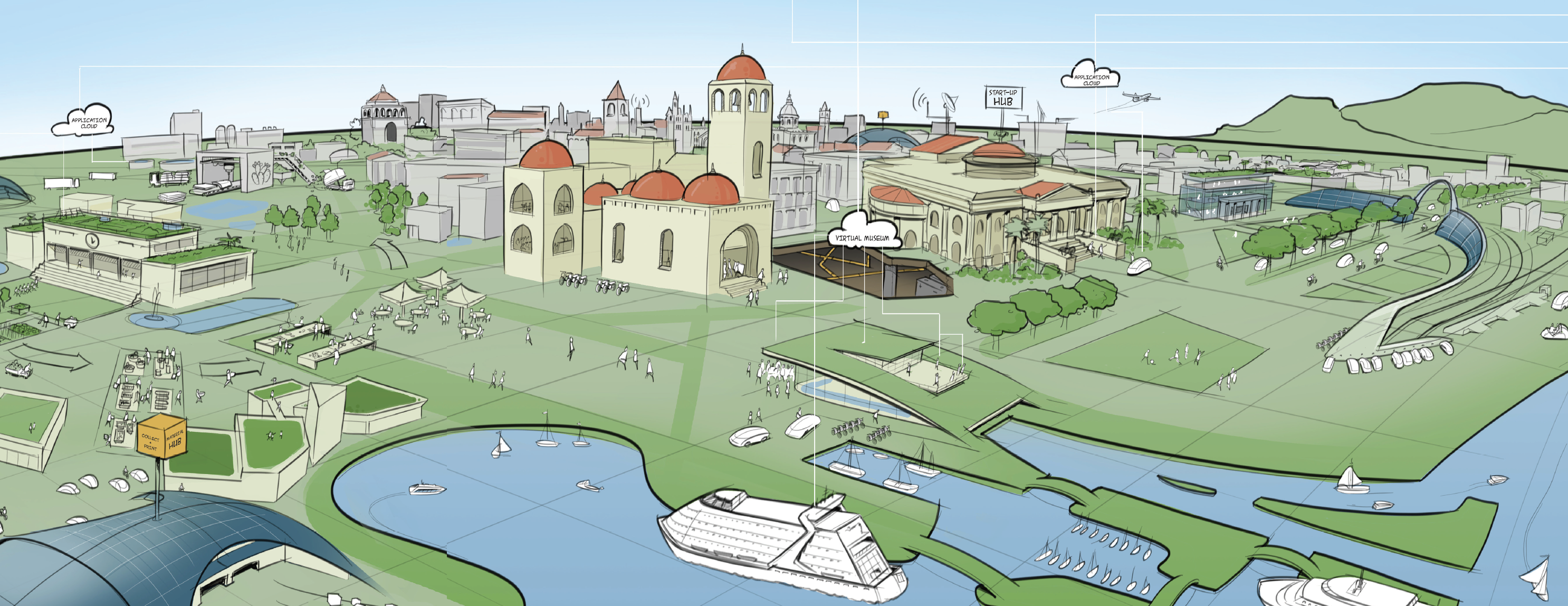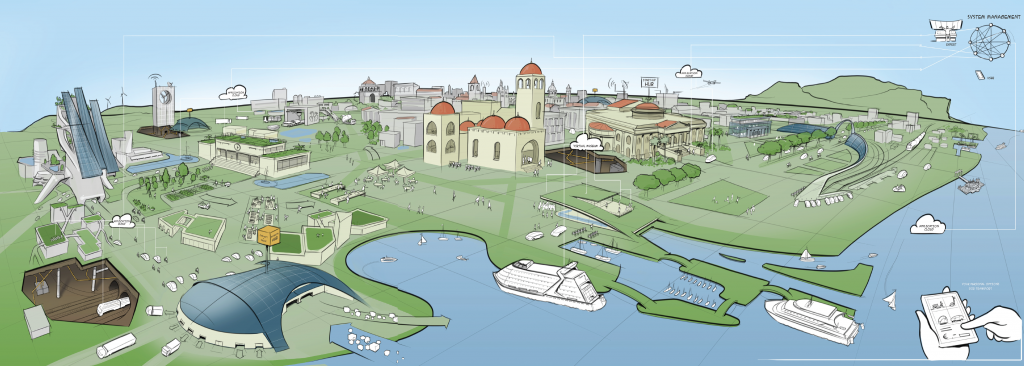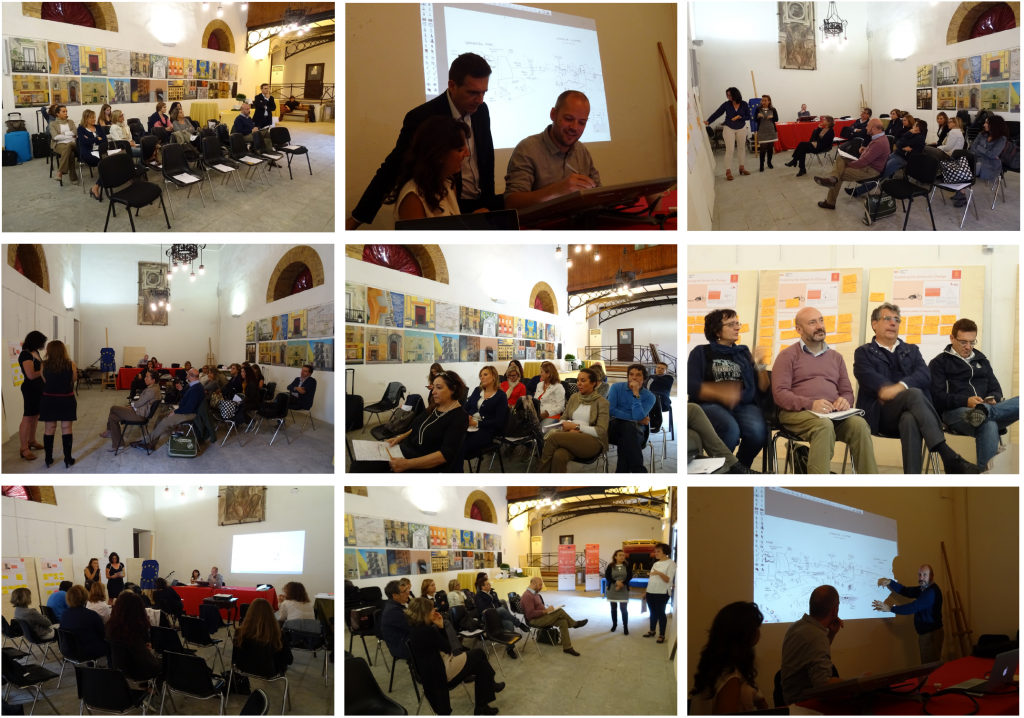Palermo Vision Development 2050

Vision development for Palermo 2050
The R4E project has completed the “Vision development” stage, which consisted of designing the services and characteristics that our cities should offer in the year 2050, based on the opinions and contributions of municipal experts of each city, their stakeholders, politicians and municipal managers. To better illustrate the process, images have been created that reflect the way our cities could look in 2050, including the services and characteristics agreed upon in the workshops for each of the project’s focus areas.
CULTURAL AND SOCIAL HARBOUR PALERMO 2050
In 2050, the city of Palermo values smart, ecological buildings, spaces and mobility. Palermo values being a social harbour, open and friendly to all, as well as a cultural harbour, enriching people’s lives and helping to make good citizenship and sustainable behaviour second nature for everyone.
Innovation and new technologies are embraced to become energy-neutral. Circular systems are implemented to enable sustainable behaviour and businesses. There is an integrated, connected, wireless data and energy network and a green mobility network connects the city and its various centres.
The core of city life is the people of Palermo, with their social interactions and their enjoyment of the city’s buildings, spaces and cultural features. Technological solutions are demand-driven and can be personally adjusted. Cultural exchanges enrich people’s lives in the city.
What characterises the city of Palermo in the focus areas of Smart Buildings and Smart Mobility and the elements of the desired future scenario are:
1. A social harbour
Palermo is an open and friendly city, welcoming to all, while retaining its unique characters. A city for the people, that is lighter, in the sense of fewer cars, less pollution and lower noise. With buildings and spaces that are comfortable for people and that exploit Palermo’s beauty, with its attractive views and sound scape.
2. A cultural harbour
Palermo cherishes its historical city centre and cultural heritage. These are enriched by new technologies and innovation to to create comfortable, energy-efficient housing and neighbourhoods. Innovative solutions are used to maintain historical buildings and to make them energy efficient. (Re-) location of public service buildings and re-purposing of old buildings supports sustainable living.
3. Circularity
Palermo greatly values new technologies as a means to become an energy-efficient and circular city. Especially in the outlying areas, new technologies are used for energy generation, storage and charging of ‘sweet mobility’ solutions. Circular systems are used, for example for food: from urban farming, markets, joint cooking and enjoying local food, as well as organic waste recycling. Or for the business of natural materials: from green roofs, natural materials for isolation, local entrepreneurship in printing isolation materials from waste of local food production. School buildings serve as demonstrators of new solutions and behavioural change.
4. An integrated, connected, wireless data and energy network
The city of Palermo is connected and accessible through a network of infrastructure for energy systems and open data. An energy network connecting the whole city based on renewable energy sources ensures energy-neutrality at city level. Energy production (PV, buildings), storage (cars and batteries) and usage (where needed) are balanced through the
network. Open data is the norm, and enables new entrepreneurship based on services for people. The connected data is valued by citizens because of the improved affordable and reliable information on mobility and public transport. Citizens support this principle of data sharing by providing access to their own data. The connected data is valued by information management experts for the interconnection of mobility modes and the integration with other functionalities, such as measuring air quality, pollution or congestion
5. City for the people of Palermo
The heart of the city of Palermo are its people, enjoying social interactions and the city’s buildings and spaces. These spaces have been given back to the people, so they can enjoy them in comfort and safety. Children can play outdoors, and can walk to school. The urban space is used by citizens, developing cultural activities and by local entrepreneurs to create awareness and change. Tourists also value the city’s cultural history, which they can experience both physically and virtually.
6. A green mobility network
The city of Palermo has been (re-)designed with a green mobility network, connecting the city and its various centres, adding value to the poly-centric city and integrating the qualities of the different areas into a harmonious whole. The Golden Valley 2.0 connects green roofs and walking areas to make walking and biking into obvious choices for people. All areas are easily accessible and safe, with a closely-knit transport network throughout the city.
7. “Sweet and green” mobility
A range of mobility solutions provide a dense network of mobility modes. This demand-driven diversity includes walking, bike, scooter, and car sharing, as well as tram metro connections to the outlying areas. Individual solutions are accessible and affordable for all, supported by local entrepreneurs, new business models and both public private investments.
8. Sea motorway and central distribution centre
Palermo is a capital city and an important sea port which serves as a logistics and transport hub, connecting the hinterland with other Italian cities. The sea will be further exploited as a mobility option to reduce traffic volumes on the roads, with a logistics platform based on new technologies. Good transport management also allows smaller-scale ecological solutions, such as smart individual delivery of (personal) goods in the city.
All these ideas and input have emerged from the participatory workshops that have taken place in the city of Palermo and whose images can be seen below:


Leave a Comment